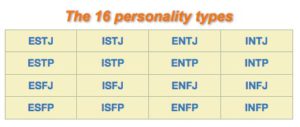- You are here:
- Home »
- Blog »
- Exploring Your Internal Map Of Reality (Series) »
- Exploring Your Internal Map Of Reality – Part 7: Metaprograms, Part 2
Exploring Your Internal Map Of Reality – Part 7: Metaprograms, Part 2
(Continued from Part 1)
 Last time we discussed the first 4 metaprograms that contribute to our internal map of reality: extrovert/introvert, sensor/intuitor, thinker/feeler and judger/perceiver.
Last time we discussed the first 4 metaprograms that contribute to our internal map of reality: extrovert/introvert, sensor/intuitor, thinker/feeler and judger/perceiver.
These 4 filters have been incorporated into so-called ‘personality theory’ as put forward by Isabelle Myers-Briggs and Katherine Myers – the so called Briggs-Myers test.
However, there is another set of metaprograms that are less regarded as part of ‘personality’ that also define our interaction with the outside world.
Direction Filters
 The Direction Filter indicates things such as like or dislike, towards or away, want or don’t want.
The Direction Filter indicates things such as like or dislike, towards or away, want or don’t want.
For instance, we could ask someone:
“What’s important to you about ___?”
“What do you want in a car?”
Some people will phrase it as ‘I want a comfortable house with efficient heating’ – these people would be using the ‘towards‘ direction filter.
Other people will phrase it as “I don’t want a house that falls down and is freezing’ – this is the ‘away‘ filter.
Similarly, when you ask someone what they want in life, they will state it in terms of what they don’t want, not in terms of what they do want. Such people often end up getting what they don’t want because the are focusing on it all the time.
If you want to be rich, that’s great, but if you say ‘I don’t want to be poor’, this will keep you keep focusing on it and keep you poor.
In the movie ‘The Secret’ most of the participants talk about the ‘Law of Attraction‘ being ‘what you think about, comes about.’ The Law of Attraction is simply the observation that what you focus upon is usually what you experience. In this sense there is nothing magical about the Law of Attraction.
Reason filter
 The reason filter is one that sorts by Possibility or Necessity.
The reason filter is one that sorts by Possibility or Necessity.
If someone asks you why you are driving, you might say ‘because I want to get to work‘ – this is a ‘possibility’ filter.
However you could have answered ‘I have to get to work.’ This is a ‘necessity’ filter
In many ways this is similar to the direction filter (towards/away) but it is more profound.
‘Possibility‘ thinkers tend to be more successful at what they do and are very creative.
‘Necessity‘ thinkers tend to avoid things they don’t want and don’t take unnecessary risks. They tend to stay in the same job all their lives without promotion.
This filter is also a type of deletion filter. When you sort by possibility, you delete the ‘have-to’s’ and the impossibilities. Conversely when you sort by necessity or impossibility, you delete the possibilities and are thus unaware of them.
 Both outcomes could either serve or not serve you depending on the situation. The key to their effective use is to be aware of what is serving you or not serving you.
Both outcomes could either serve or not serve you depending on the situation. The key to their effective use is to be aware of what is serving you or not serving you.
The quote by St. Francis of Assisi illustrates this best.
Frame of Reference filter: internal or external.
In any group of people there will be a number who have what is called an ‘Internal‘ frame of reference. They know things are OK within themselves and do not need the opinion of others.
Similarly there will be another group who consistently rely on others for feedback. These people have an ‘external‘ frame of reference.

Is this guy inside or outside the house?
There are times when one serves better than the other, but often people stick with one or the other even if it doesn’t serve them to do so.
Internal referencing people can mistakenly rely on their own judgement when it’s not appropriate. Similarly, external referencers are lost when they are forced to fall back on their own resources.
The key here is to apply this filter in a way that serves us the best. A very good example of a resourceful use of both sides of the filter is the Scientific Method.
- Initially someone has a hypothesis (internal frame of reference).
- As more information is received (external frame of reference), it becomes a theory (internal plus external frame of reference).
- Further corroboration by others (external frame of reference) will either prove or disprove the theory.
For instance, I have a hypothesis that all cats are green. (internal reference)
I then look for information that supports that hypothesis.
Drat! I can’t seem to find any green cats! (not going too well here! [external reference])
I ask my friends ‘have you ever seen a green cat?’ and they say ‘No, never’ (external corroboration/frame of reference)
I conclude: ‘Well, there are no green cats'(internal plus external frame of reference)
But then I see this!
Click here to read part 3 of metaprograms
